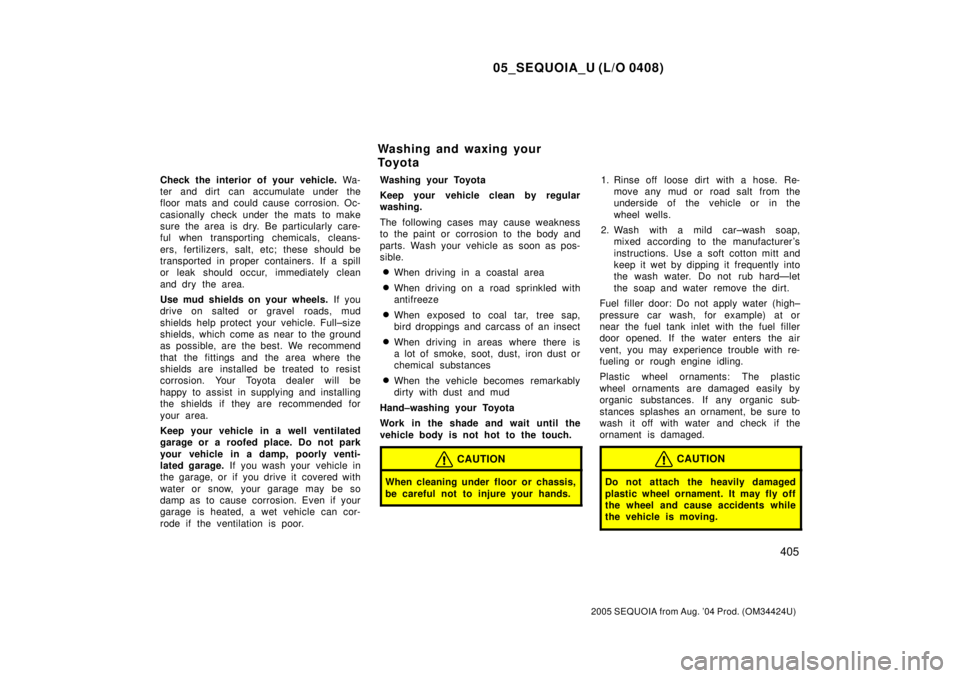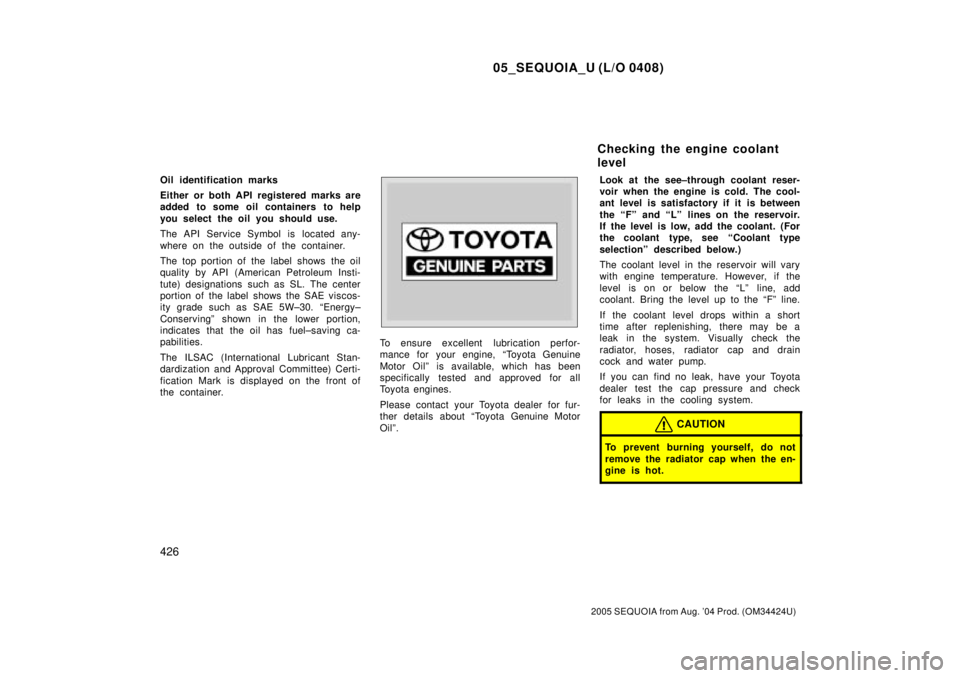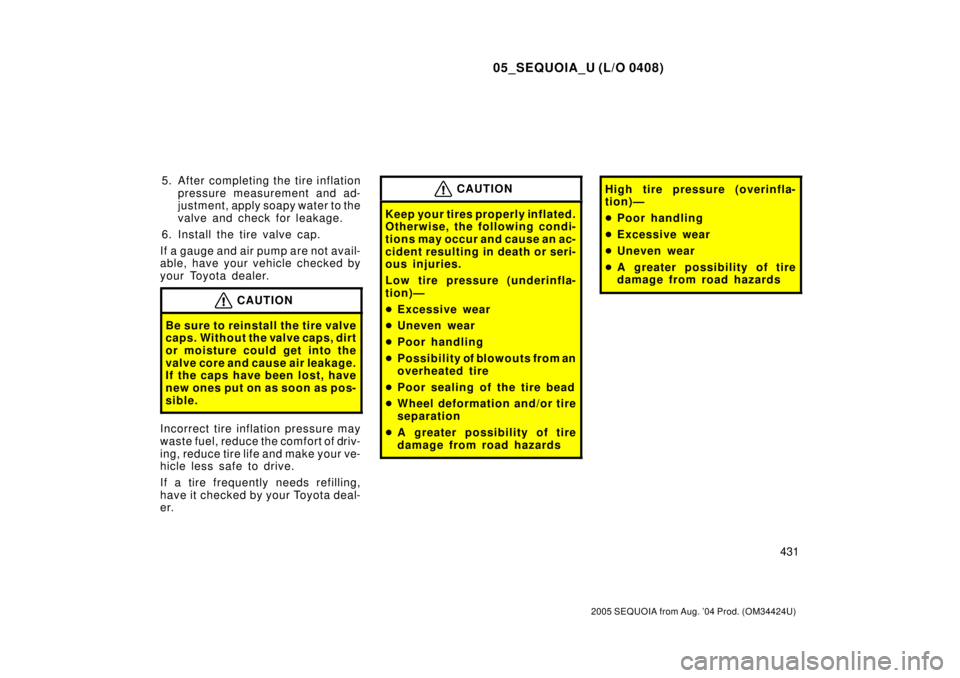Page 4264 of 4323

05_SEQUOIA_U (L/O 0408)
405
2005 SEQUOIA from Aug. '04 Prod. (OM34424U)
Check the interior of your vehicle. Wa-
ter and dirt can accumulate under the
floor mats and could cause corrosion. Oc-
casionally check under the mats to make
sure the area is dry. Be particularly care-
ful when transporting chemicals, cleans-
ers, fertilizers, salt, etc; these should be
transported in proper containers. If a spill
or leak should occur, immediately clean
and dry the area.
Use mud shields on your wheels. If you
drive on salted or gravel roads, mud
shields help protect your vehicle. Full±size
shields, which come as near to the ground
as possible, are the best. We recommend
that the fittings and the area where the
shields are installed be treated to resist
corrosion. Your Toyota dealer will be
happy to assist in supplying and installing
the shields if they are recommended for
your area.
Keep your vehicle in a well ventilated
garage or a roofed place. Do not park
your vehicle in a damp, poorly venti-
lated garage. If you wash your vehicle in
the garage, or if you drive it covered with
water or snow, your garage may be so
damp as to cause corrosion. Even if your
garage is heated, a wet vehicle can cor-
rode if the ventilation is poor.Washing your Toyota
Keep your vehicle clean by regular
washing.
The following cases may cause weakness
to the paint or corrosion to the body and
parts. Wash your vehicle as soon as pos-
sible.
�When driving in a coastal area
�When driving on a road sprinkled with
antifreeze
�When exposed to coal tar, tree sap,
bird droppings and carcass of an insect
�When driving in areas where there is
a lot of smoke, soot, dust, iron dust or
chemical substances
�When the vehicle becomes remarkably
dirty with dust and mud
Hand±washing your Toyota
Work in the shade and wait until the
vehicle body is not hot to the touch.
CAUTION
When cleaning under floor or chassis,
be careful not to injure your hands.
1. Rinse off loose dirt with a hose. Re-
move any mud or road salt from the
underside of the vehicle or in the
wheel wells.
2. Wash with a mild car±wash soap,
mixed according to the manufacturer 's
instructions. Use a soft cotton mitt and
keep it wet by dipping it frequently into
the wash water. Do not rub hardÐlet
the soap and water remove the dirt.
Fuel filler door: Do not apply water (high±
pressure car wash, for example) at or
near the fuel tank inlet with the fuel filler
door opened. If the water enters the air
vent, you may experience trouble with re-
fueling or rough engine idling.
Plastic wheel ornaments: The plastic
wheel ornaments are damaged easily by
organic substances. If any organic sub-
stances splashes an ornament, be sure to
wash it off with water and check if the
ornament is damaged.
CAUTION
Do not attach the heavily damaged
plastic wheel ornament. It may fly off
the wheel and cause accidents while
the vehicle is moving.
Washing and waxing your
To y o t a
Page 4285 of 4323

05_SEQUOIA_U (L/O 0408)
426
2005 SEQUOIA from Aug. '04 Prod. (OM34424U)
Oil identification marks
Either or both API registered marks are
added to some oil containers to help
you select the oil you should use.
The API Service Symbol is located any-
where on the outside of the container.
The top portion of the label shows the oil
quality by API (American Petroleum Insti-
tute) designations such as SL. The center
portion of the label shows the SAE viscos-
ity grade such as SAE 5W±30. ªEnergy±
Conservingº shown in the lower portion,
indicates that the oil has fuel±saving ca-
pabilities.
The ILSAC (International Lubricant Stan-
dardization and Approval Committee) Certi-
fication Mark is displayed on the front of
the container.
To ensure excellent lubrication perfor-
mance for your engine, ªToyota Genuine
Motor Oilº is available, which has been
specifically tested and approved for all
Toyota engines.
Please contact your Toyota dealer for fur-
ther details about ªToyota Genuine Motor
Oilº.Look at the see±through coolant reser-
voir when the engine is cold. The cool-
ant level is satisfactory if it is between
the ªFº and ªLº lines on the reservoir.
If the level is low, add the coolant. (For
the coolant type, see ªCoolant type
selectionº described below.)
The coolant level in the reservoir will vary
with engine temperature. However, if the
level is on or below the ªLº line, add
coolant. Bring the level up to the ªFº line.
If the coolant level drops within a short
time after replenishing, there may be a
leak in the system. Visually check the
radiator, hoses, radiator cap and drain
cock and water pump.
If you can find no leak, have your Toyota
dealer test the cap pressure and check
for leaks in the cooling system.
CAUTION
To prevent burning yourself, do not
remove the radiator cap when the en-
gine is hot.
Checking the engine coolant
level
Page 4290 of 4323

05_SEQUOIA_U (L/O 0408)
431
2005 SEQUOIA from Aug. '04 Prod. (OM34424U)
5. After completing the tire inflation
pressure measurement and ad-
justment, apply soapy water to the
valve and check for leakage.
6. Install the tire valve cap.
If a gauge and air pump are not avail-
able, have your vehicle checked by
your Toyota dealer.
CAUTION
Be sure to reinstall the tire valve
caps. Without the valve caps, dirt
or moisture could get into the
valve core and cause air leakage.
If the caps have been lost, have
new ones put on as soon as pos-
sible.
Incorrect tire inflation pressure may
waste fuel, reduce the comfort of driv-
ing, reduce tire life and make your ve-
hicle less safe to drive.
If a tire frequently needs refilling,
have it checked by your Toyota deal-
er.
CAUTION
Keep your tires properly inflated.
Otherwise, the following condi-
tions may occur and cause an ac-
cident resulting in death or seri-
ous injuries.
Low tire pressure (underinfla-
tion)Ð
�Excessive wear
�Uneven wear
�Poor handling
�Possibility of blowouts from an
overheated tire
�Poor sealing of the tire bead
�Wheel deformation and/or tire
separation
�A greater possibility of tire
damage from road hazards
High tire pressure (overinfla-
tion)Ð
�Poor handling
�Excessive wear
�Uneven wear
�A greater possibility of tire
damage from road hazards